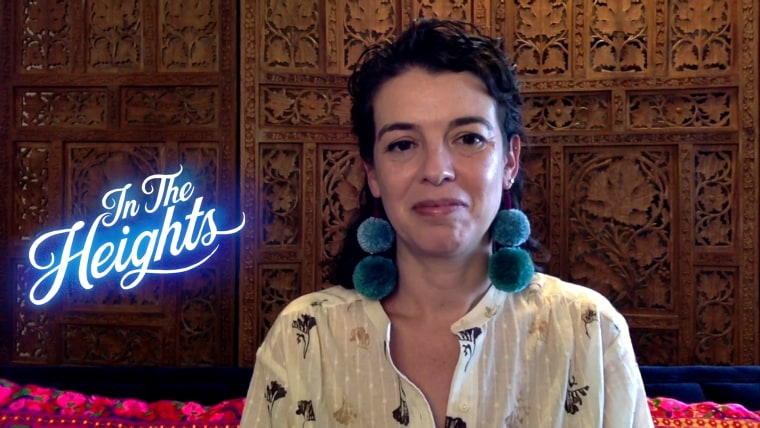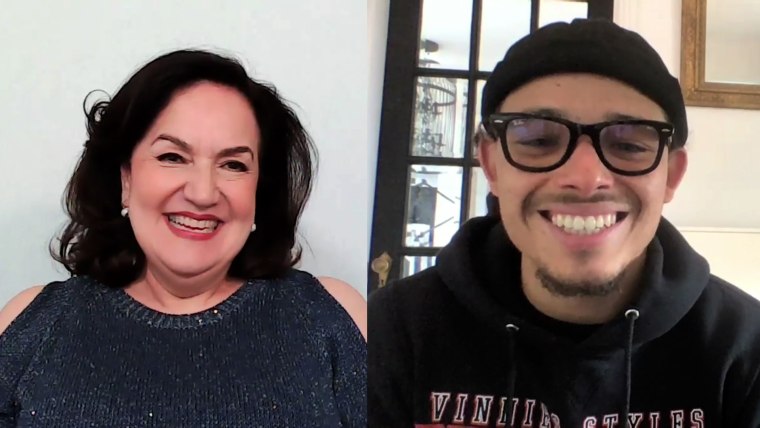Lin-Manuel Miranda was 19 when he first wrote what he called “a very bad musical” that saw only five notes make it into the final version of "In the Heights," which won four Tony Awards following its Broadway premiere in 2008.
Now, after a long trek to get the right studio to produce the film adaptation, the highly anticipated movie premieres Thursday. Like the stage version, it breaks ground because it centers on Latino characters that have long been missing in mainstream films, TV shows and theater productions.
"In the Heights" tells the stories of generations of residents and business owners in the predominantly Latino neighborhood of New York City's Washington Heights — where Miranda, now 41, grew up. They're balancing their personal aspirations with fighting for their tight-knit community as wealthier outsiders start moving in, threatening to displace them.
Miranda and his co-writer, Pulitzer Prize-winning playwright Quiara Alegría Hudes, had to fight movie executives and producers who wanted to rely on worn-out tropes that have disproportionately portrayed Latinos as the help, criminals or individuals who only live trauma-ridden lives.
“Quiara and I stuck to our guns and stuck to what we felt was important in the storytelling of the show,” such as having Nina, one of the main characters, embody the internal conflicts a first-generation college student, Miranda told NBC News. Making that central female character a smart, Stanford University student was one of the many intentionally created roles that resonated with Latino audiences when the musical came out.
Achieving nonstereotypical portrayals of Latinos required “a lot of gut checks” during the revision process, to ensure it stayed true to "what are your non-negotiables," Miranda said.
He remembered a time in which a producer he admires made him doubt his own ability to compose the music for “In the Heights.”
“The people who are in the margins of other people's stories so much of the time in mainstream Hollywood or mainstream Broadway, they get the spotlight.” — Lin-Manuel Miranda
"And then my gut made me sick to my stomach," Miranda said. "And I said, 'If I don't know how to write the songs for this neighborhood, then no one knows how to write the songs for this neighborhood. It's the one thing I know I actually can do.'"
The movie's overload of Latino visibility, from the main cast to the extras, brought an opportunity for talented Latino creatives to spotlight the dynamism, humanity and struggles of a community that often feels unnoticed.
“That summer of 2019 filming the movie was so magical, but it almost didn't feel real,” Miranda said about filming the movie in his own neighborhood, in the northern part of Manhattan.
Hudes, who wrote the book for the musical version of “In the Heights” and the screenplay for the film adaptation, said part of that magic comes from the film’s inherent “healing spirit.”
“Part of that healing happens through exuberant music and dance. Another part of that healing happens through the individual stories, and even though everyone has a different path in this movie, they are connected by similar questions — especially as immigrants, as migrants. Is over there home? Is here home? Is there only one home or can we carry many homes within us?” Hudes said. “What about when we love this home, but we have dreams to go beyond it? Is that betraying this home?”
Making new stars
Like "Black Panther" did for Black actors and "Crazy Rich Asians" for Asian actors, "In the Heights" stands out for showcasing Latino talent, including faces and voices who are not yet household names.
In an analysis, the University of Southern California Annenberg Inclusion Initiative found that only 4.9 percent of the speaking roles in 2019’s top movies went to Latinos, even though they represent nearly 19 percent of the nation's population. Forty-four of the 100 top movies that year had absolutely no Latino characters with speaking roles, a rate that did not differ much from 2018 (47 movies) or 2015 (40 movies).
“We’re making up for lost time,” Miranda said.
In an effort to curb this trend, Hudes said she's intentional when she writes.
“As a playwright, as a screenwriter, I'm creating jobs. I get to create roles for actors. And so, I think very carefully about what would be a great job to create,” she said.
With the help of film director Jon M. Chu, the filmmakers cast an effective mix of new, up-and-coming talent and known veteran actors such as Jimmy Smits and Olga Merediz, who's reprising her beloved role as Abuela Claudia (Grandmother Claudia) from the original Broadway version. The formula of established and new actors proved successful in Chu’s 2018 blockbuster "Crazy Rich Asians.”
“He wanted to make stars” and “invite in a new generation of talent who really haven't had the opportunities yet on this big platform,” Hudes said of Chu’s vision.
Leading that new generation of Latino actors in the Hollywood film is Anthony Ramos, who stars as Usnavi, a bodega owner who dreams of returning to the Dominican Republic.
Growing up in Bushwick in Brooklyn, another predominantly Latino neighborhood in New York City, and playing Usnavi for three weeks at a Kennedy Center production in 2018 gave Ramos the right amount of personal and professional experience to nail his biggest role since appearing in the Oscar-winning film “A Star Is Born” and originating the roles of John Laurens and Philip Hamilton in Miranda’s award-winning, massive Broadway hit “Hamilton.”
Ramos, 29, had a motto on set: “This is for the motherf------ culture. Let’s go,” he would say in true hype man fashion.
Ramos said the thought that “this movie is about something that's so much greater than you” helped him power through long hours of rehearsals and shoots, no matter how tired he felt. At the same time, he said, his inner child would remind him how much he wished for a movie like “In the Heights” when he was growing up.
Invisible no more
Merediz, 65, said she remembers filming in Washington Heights and seeing “the real people that live there, walking down the streets and I'd go, ‘Look there's Abuela, there's Daniela,’” referring to some of the main characters from the movie.
“They were the real people from the neighborhood that we were portraying” in the film, Merediz said. “And I like to play characters like that aren’t ordinarily seen — to shine a light on that little old lady that we ignore, that’s invisible.”
In “In the Heights,” Abuela Claudia is the quintessential matriarch. She left Cuba in 1943 and settled in the neighborhood, eventually becoming the surrogate grandmother of all the young people there.
Merediz, the movie’s most likely Oscar contender, said she took inspiration from some of the mother figures in her life, including her aunt and mother.
“I wanted to make her that person that everyone went to for advice or for a nice, cooked meal,” Merediz said. “She's lived so much, she has so much to offer. But I wanted to give her that extra kindness that we all need.”
Abuela Claudia’s kind heart is on full display during Merediz’s masterful performance of what Miranda deemed “a six-minute aria” called “Paciencia y Fe” ("Patience and Faith"). In it, viewers get a glimpse of how this older woman strives to keep her dignity by holding on to a collection of details and memories that remind her of her humanity, despite the hardships.
“That to me is some of the stuff that makes this special,” Miranda said. “The people who are in the margins of other people's stories so much of the time in mainstream Hollywood or mainstream Broadway, they get the spotlight.”
When asked if “In the Heights” marks a pivotal time for Latino representation in Hollywood, Miranda responded, “I hope so.” His cautious optimism comes from his previous experience bringing “In the Heights” to Broadway and seeing how the show succeeded in boosting audience diversity and attendance during its three-year run — “and then goodbye,” Miranda said.
“What are folks writing? What are you producing? What are you putting your money behind on stage?” Miranda said. “If you don't build it, they won't come, and if you don't support Latino talent behind the scenes.”
But Merediz feels more optimistic about this moment.
“I think it's a turning point,” she said. “Finally, after trying so much. Is this our time? Is this our time? No, I think this is our time.”
Follow NBC Latino on Facebook, Twitter and Instagram.
"movie" - Google News
June 10, 2021 at 04:00PM
https://ift.tt/3x91Rqe
'In the Heights' breaks ground by rejecting old Latino movie tropes - NBC News
"movie" - Google News
https://ift.tt/35pMQUg
https://ift.tt/3fb7bBl
Bagikan Berita Ini

















0 Response to "'In the Heights' breaks ground by rejecting old Latino movie tropes - NBC News"
Post a Comment